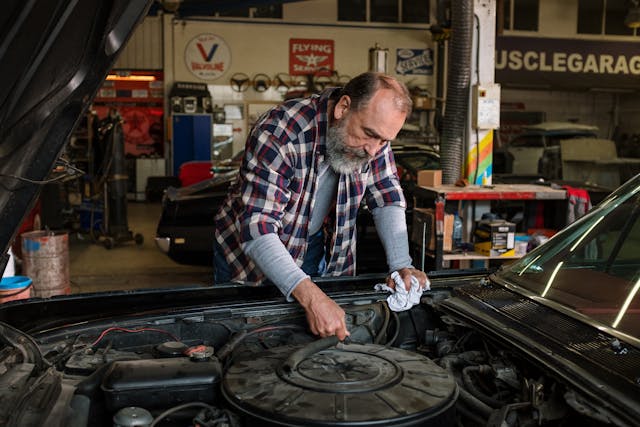With the introduction of autonomous cars, the automobile industry is about to undergo a revolution (AVs). These self-driving vehicles promise to change the face of transportation by bringing about improvements in terms of convenience, efficiency, and safety. But as technology develops and autonomous vehicles (AVs) proliferate on our roads, concerns surface over how auto repair and upkeep will change to handle these state-of-the-art cars. This article will examine how autonomous cars may affect the auto repair and maintenance market as well as how industry participants are getting ready for this game-changing development.

1. Simplified Requirements for Maintenance:
Advanced sensors, cameras, and computer systems are built into autonomous cars to let them navigate and function securely without the need for human interaction. Because of this, many conventional car mechanical parts—like manual gearboxes and intricate engine systems—are either removed or simplified in autonomous vehicles (AVs). Less components that are susceptible to wear and tear might mean less maintenance needs as a result of this mechanical complexity reduction.
2. A Focus on Electronics and Software:
Tasks related to servicing and maintaining autonomous vehicles (AVs) will increasingly center on software and electrical components. This include detecting and resolving software-related problems, keeping an eye on sensor performance, and upgrading and maintaining the car’s operating system. To properly maintain and repair AVs, automotive personnel will need specific training as well as proficiency in electronics and software engineering.
3. Using data analytics to predict maintenance:
Large volumes of data are produced by the onboard sensors and systems of autonomous cars, which provide important insights on the functionality and health of the vehicle. Manufacturers and service providers may proactively plan maintenance work and anticipate possible difficulties before they arise by using data analytics and predictive maintenance algorithms. For owners of autonomous vehicles, this switch from reactive to proactive maintenance may decrease downtime, maximize vehicle performance, and save repair expenses.
4. Over-the-air updates and remote diagnostics:
The built-in connection characteristics of autonomous cars allow for over-the-air software updates and remote diagnostics, doing away with the requirement for regular in-person trips to a service facility for software upgrades or basic maintenance. Manufacturers no longer need to pull the car out of operation in order to remotely monitor the health of the vehicle, identify problems, and apply software updates or repairs. This simplified maintenance strategy may lessen interruptions caused by service-related issues and increase convenience for AV owners.
5. Tailored Service Facilities and Instructional Courses:
There will be a greater need for skilled technicians and specialized service facilities as driverless cars become more common. These facilities will be equipped with the instruments, apparatus, and know-how required for efficient AV servicing and maintenance. To ensure they are prepared to meet the changing demands of the industry, automotive technicians will go through specialized training programs to learn how to diagnose and repair software and electrical systems specific to autonomous cars.
6. Safety Standards and Regulatory Compliance:
Autonomous vehicle servicing and maintenance will be heavily influenced by safety regulations and standards, just as with any new technology. To maintain the safety and dependability of AV cars, manufacturers and service providers will have to abide by strict laws controlling AV design, operation, and maintenance. Furthermore, industry participants and regulators need to work together to create standards for AV servicing and maintenance procedures that put customer safety and security first.

7. Integration of Telematics and Fleet Management:
It is anticipated that the use of autonomous cars would completely change fleet management procedures. Autonomous technology will be used more often by firms and organizations that depend on fleets of vehicles, such as ride-hailing services, delivery services, and public transit systems, in an effort to save expenses and increase operational efficiency. When AVs are equipped with telematics systems, real-time data on performance parameters, maintenance requirements, and vehicle position will be available. By scheduling maintenance, minimizing downtime, and optimizing routes, fleet managers may maximize the productivity and profitability of their fleets.
8. Maintenance Models Based on Subscriptions:
Traditional ownership models may be replaced by subscription-based services where users pay a monthly fee to have access to a fleet of autonomous cars as AVs become more and more common. Under this scenario, customers would not have to worry about individual car upkeep because maintenance and servicing duties would probably be included in the subscription price. In order to enhance customer happiness and retention, service providers would be in charge of guaranteeing the AV fleet’s continued health and dependability and would give incentives for proactive maintenance and performance improvement.
9. Working Together with Technology Partners:
Automakers and service providers will work more closely with technology partners as autonomous vehicle technology develops quickly in order to remain ahead of the curve. These collaborations might be cooperative R&D projects, technological licensing contracts, or strategic alliances to capitalize on one another’s resources and experience. Industry participants can speed up innovation, improve product offerings, and provide cutting-edge solutions to satisfy the changing demands of AV owners and operators by using their combined expertise and skills.
10. Dealing with Cybersecurity Issues:
Cybersecurity will become a major worry for the automobile sector as autonomous cars grow increasingly networked and dependent on digital technologies. It will be crucial to defend AVs against cyberthreats like malware, hacking, and data breaches in order to guarantee the security and integrity of these vehicles. To protect AVs from cyberattacks and illegal access, automakers, service providers, and cybersecurity specialists must work together to create strong security protocols, encryption standards, and intrusion detection systems.
In summary:
A new age of innovation, efficiency, and convenience is about to arrive in the automobile repair and maintenance industry with the development of autonomous cars. Service providers will need to modify their procedures to match the particular requirements of these state-of-the-art cars as AV technology develops. Through the adoption of predictive maintenance techniques, the utilization of telematics and data analytics, investigation of subscription-based business models, cooperation with technology partners, and emphasis on cybersecurity, the automotive service and maintenance sector can proficiently manage the shift towards an autonomous future. Service providers may establish themselves as industry leaders in the autonomous mobility future by providing unmatched value and dependability to AV owners and operators equally with careful planning, investment, and cooperation.